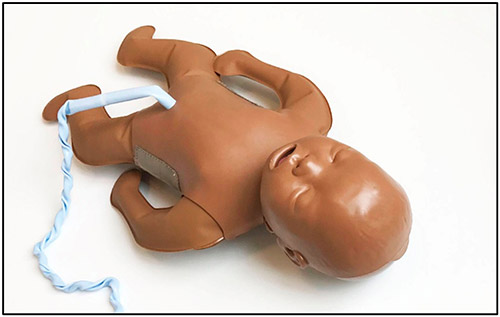Focused bag-mask ventilation training for neonatal resuscitation is critically important for frontline providers. Effective bag-mask ventilation (BMV) training involves the use of correct technique as well as the timely application of MRSOPA ventilation corrective steps that include:
M Mask adjustment
R Reposition airway
S Suction mouth and nose
O Open the mouth
P Pressure increase
A Alternative airway
In newborns born apneic, the quick enaction of successful BMV is vital to their survival and can prevent the need for more intensive resuscitation. Therefore, all providers who attend deliveries should be knowledgeable in the performance and assessment of this life-saving skill.
In the March 4, 2022, issue of Children, neonatologists Catherine L. Chang, MD, Jeffrey Perlman, MB, ChB, and pediatric hospitalist Erika Abramson, MD, MSc, at NewYork-Presbyterian Komansky Children’s Hospital, describe the importance of focused ventilation training for frontline providers and demonstrate how NeoNatalie™ Live, a novel manikin, can be integrated into an individualized ventilation training program. They describe the use of NeoNatalie Live’s “scenario training” mode in sessions with an instructor, its capabilities and objective data outputs, and illustrate the manikin’s usefulness in a neonatal resuscitation refresher course.

NeoNatalie Live manikin
At NewYork-Presbyterian Komansky, pediatric residents and advanced practice providers, including specially trained delivery room nurses, physician assistants, nurse practitioners, and hospitalists, attend low- to moderate-risk deliveries as first responders. In this capacity, they must be proficient in promptly initiating effective BMV as they await arrival of the rest of the neonatal advanced practice team. Yet, research has shown that delivery room experience and the skill to perform bag-mask ventilation among frontline providers varies. In a study of pediatric resident performance of neonatal resuscitation in the delivery room, only 54 percent of residents competently performed the MRSOPA progression when ventilation corrective steps were called into action.
Simulation is often used as the primary modality for training and appraisal of competency. However, it is frequently difficult to assess an individual’s ability to perform the ventilation corrective steps as providers often take part in neonatal resuscitation simulations as a team and/or are assessed on the performance of the entire neonatal resuscitation program algorithm.
Today there is increasing emphasis on automated skills training, where learners can independently practice skills on a simulator without an instructor present. “While the effective delivery of these skills is important to the overall quality of the resuscitation,” notes the Weill Cornell Medicine researchers, “providers must also be able to identify when these skills are needed, recognize and troubleshoot problems in real time, and ably execute them in situations of high stress.”
NeoNatalie Live: Building Confidence and Competency
Description
NeoNatalie Live, a second-generation inflatable newborn simulator, automatically detects head position, mask seal, ventilation attempts, ventilation pressure, and ventilation rate. A valve controlling the opening of the airway simulates “normal” or “low” lung compliance, which can be chosen by a facilitator during a simulation scenario. The manikin also provides a heart rate response to the quality and length of ventilation provided.
The NeoNatalie Live manikin is primarily designed for airway simulation and is optimized for education related to the initial portion of the neonatal resuscitation program algorithm, bag-mask ventilation, and the ventilation corrective steps.
Four different case scenarios of varying difficulty based on “lung compliance” (normal/low) and initial heart rate (normal/low) are available. In the “normal compliance” mode, ventilation pressures of 15 to 20 cmH2O will result in chest rise, leading, in turn, to increasing heart rate. In the “low compliance” mode, higher ventilation pressures (~30 cmH2O) are required to initiate chest rise. Effective delivery of these higher pressures with the head/neck aligned in the appropriate sniffing position and a good mask seal against the face results in a gradual improvement in chest rise and an increase in heart rate.
The NeoNatalie Live manikin is primarily designed for airway simulation and is optimized for education related to the initial portion of the neonatal resuscitation program algorithm, bag-mask ventilation, and the ventilation corrective steps. Learners are unable to place an advanced airway, cannulate the umbilical cord or obtain realistic feedback with chest compressions.
Modes of Training
There are two training modes: individual based and scenario based. In the individual training mode, learners may choose a scenario and practice ventilation based on prompts on the tablet application. Feedback on the ventilation performance related to airway positioning, rate and pressure delivered are provided to the user by the application during and after a practice session. In this mode, NeoNatalie Live can been used for automated, independent BMV training without an instructor.
In the scenario training mode, a facilitator expands the training to include the additional assessment of other important clinical and cognitive skills, such as the performance of the initial steps, requesting additional help, asking for heart rate, etc. This mode also enables modulating of the complexity of scenarios, allowing for an increased range of learning objectives. Learners are confronted with real life delivery room scenarios. The ability to control chest rise and the corresponding effect on heart rate is a compelling feature that allows instructors to regulate the difficulty of the experience. Closing the airway with a declining heart rate presents the learner with a stressful situation where the newborn is not responding immediately to routine measures. The Weill Cornell Medicine researchers noted, “This serves as a critical learning experience and opportunity to practice clinical assessment, decision making and the execution of interventions. Repeated practice may also improve provider comfort in managing such high-pressure scenarios independently.”




